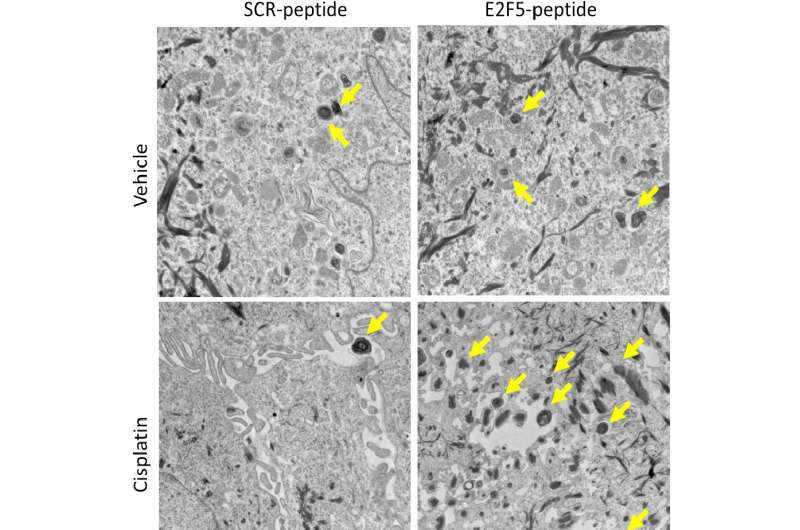From bed to bench and back to bed: Mimicking how HPV-positive cancer responds to treatment

Patients with head and neck squamous cell carcinoma who are positive for human papilloma virus (HPV-positive) have been observed to respond significantly better to chemo-radiotherapy than HPV-negative patients. This observation is surprising because HPV infection leads to an increased risk of developing oropharyngeal cancer. To date, the reason for this dichotomy has not been well understood.
In an article in the August 2017 issue of EMBO: Molecular Medicine, researchers and clinicians at the Medical University of South Carolina (MUSC) Hollings Cancer Center report having identified one of the underlying mechanisms—expression of the viral protein E7 leads to cell death through mitophagy, a process that destroys the mitochondria. They went on to develop a novel peptide that mimics this pathway and improves therapeutic intervention in HPV-negative head and neck cancers.
"This study looked at both the clinical aspects as well as the mechanistic and therapeutic aspects of oral cancer. We are very excited about these findings because they represent what is happening in the clinic," says Besim Ogretmen, Ph.D., senior author for this study, director of the Lipidomics Shared Resource Center and professor of Biochemistry and Molecular Biology at MUSC.
Ogretmen's laboratory has a history of studying mitochondria as well as a specific lipid, ceramide. Association of ceramide with mitochondria elicits a decrease in energy production as well as an increase in the production of toxic molecules called reactive oxygen species. The findings described in their recent work bridges these two areas of study and describes a mechanism of cell death termed ceramide-induced mitophagy, which plays an important role in killing oral cancer cells.
Ceramide-induced mitophagy is a two-pronged approach to killing cancer cells. The first prong involves treating cancer cells with cisplatin, a chemotherapeutic agent that mimics ceramide. The treated cells accumulate ceramide at the mitochondria. The second prong involves the viral protein E7. The E7 protein liberates the cellular protein E2F5, which is then capable of binding another cellular protein called dynamin related protein 1 (DRP1). This complex is then targeted to the mitochondria. Importantly, it is the combined presence of ceramide and DRP1 at mitochondria that prompts mitochondrial degradation and ultimately cell death.
Having described the mechanism by which HPV-positive cancer cells succumb to chemotherapy, the Ogretmen lab next wanted to determine if they could apply these findings to HPV- cancers, since patients with these cancers are much more likely to succumb to their disease relative to patients with HPV-related cancer.
"Based on these mechanistic findings, we developed a peptide that can mimic the HPV effects without the HPV infection," says Ogretmen.
In order to accomplish this, they developed a peptide that mimics the interaction of the cellular proteins E2F5 and DRP1. Treatment of HPV- oral cancer cells with cisplatin and this novel peptide led to increased cell death in a manner that was similar to treatment of HPV-positive cancer cells with cisplatin. Further experiments showed that this peptide was effective at killing HPV cancer cells in a mouse model.
Future studies are aimed at better understanding the mechanism by which ceramide is incorporated into mitochondria. How does ceramide enter the cell? How is ceramide transported to the mitochondria? Better understanding of this pathway may provide further avenues for improved treatment with cisplatin or other ceramide-like compounds.
Overall, these results demonstrate that chemotherapy is much more effective in HPV-positive cancer cells and that this improved efficacy can be achieved in HPV-negative cancer cells through co-treatment with an E2F5 peptide.
"We are very excited about the potential therapeutic aspects of this peptide; however, developing a drug and taking that drug to the clinic takes a lot of effort and a lot of funding," says Ogretmen.
There are many hurdles that have to be overcome before this novel treatment becomes available in the clinic. One of the first hurdles is manufacturing large quantities of the peptide using good laboratory practices, which is a requirement of the Food and Drug Administration. Once these protocols have been established, clinical trials testing the safety and efficacy of this combinatorial therapy can begin.
This work was achieved through the coordinated collaboration of clinicians and basic science researchers and exemplifies the "bed to bench to bed" mantra that scientific research strives to achieve. Patients were asked to donate the leftover cancer tissue from their surgery. Then the tissues were tested in the lab and in animal models. Now, the results of these tests are to be taken back into the clinic (bedside) in an attempt to treat patients with HPV-negative head and neck cancers.
"Given the profound impact of HPV status on survival, it has become clear that understanding the mechanisms driving the sensitivity of HPV-related disease to cytotoxic therapies could provide the foundation for novel therapies in HPV-negative head and neck cancer," says David Neskey, M.D., a surgeon at MUSC Hollings Cancer Center specializing in the treatment of head and neck cancers.
More information: Raquela J Thomas et al, HPV/E7 induces chemotherapy‐mediated tumor suppression by ceramide‐dependent mitophagy, EMBO Molecular Medicine (2017). DOI: 10.15252/emmm.201607088


















